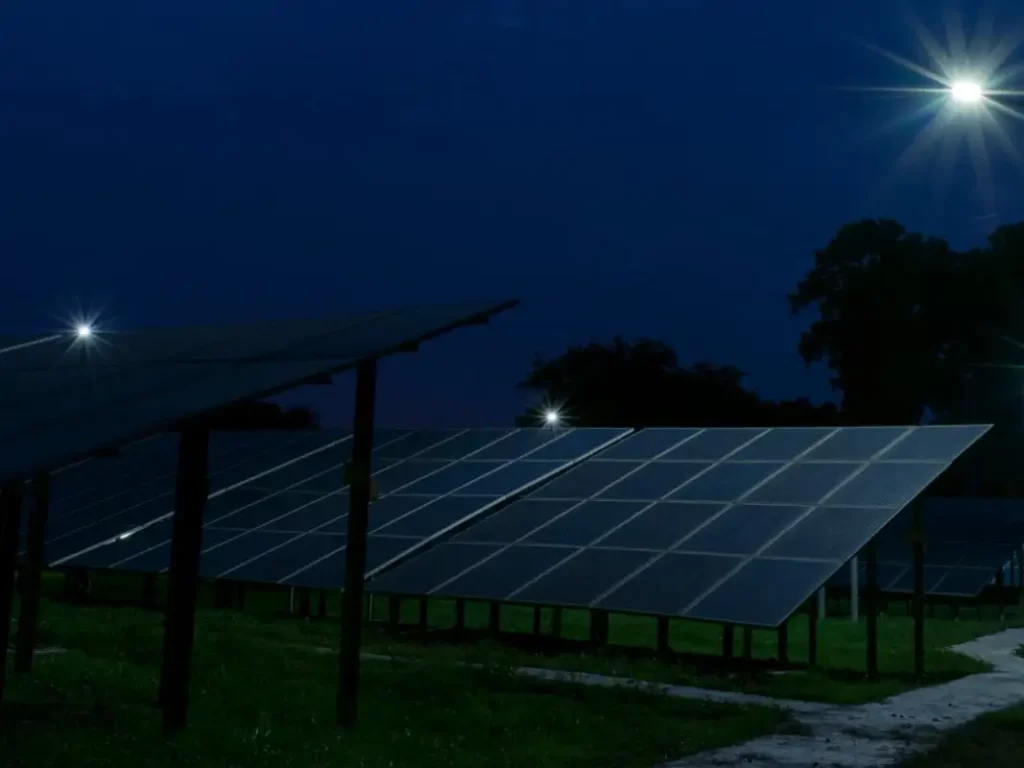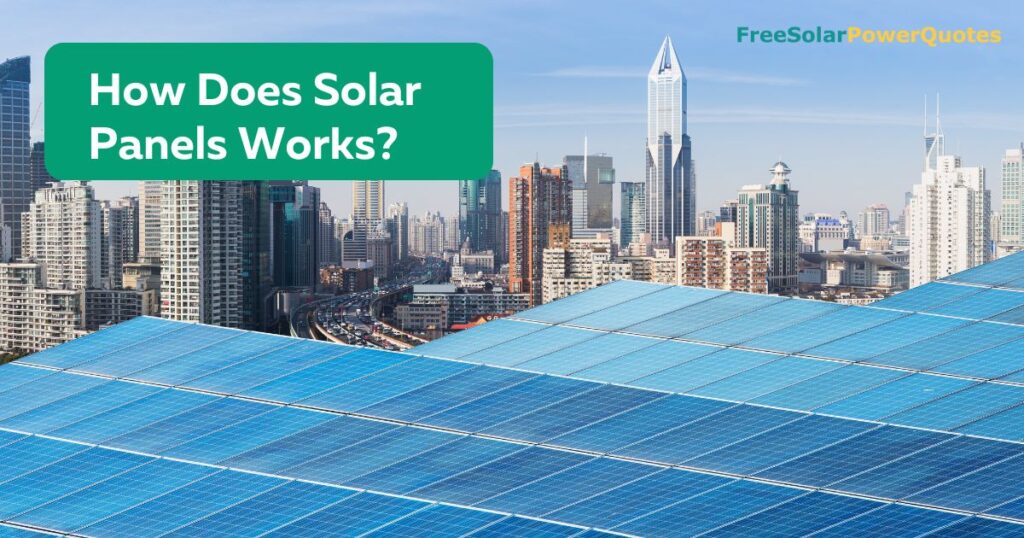Solar panels are a popular way for homeowners and businesses to generate clean, renewable energy. They work by converting sunlight into electricity using photovoltaic cells. This article will provide a detailed explanation of how does solar panel works and the science behind the conversion of sunlight into electricity.
The Basics of Photovoltaics:
One way sunlight can be turned into energy is through photovoltaics (PV). This is done by using photovoltaic cells, also known as solar cells, that are made from materials such as silicon that are capable of absorbing photons (light particles) and releasing electrons. These electrons are then captured and used to generate an electrical current.
The Components of a Solar Panel:
A solar panel is made up of multiple photovoltaic cells that are connected together to form a module. The modules are then connected to form an array capable of generating a significant amount of electricity. Solar panels are important because they harness the sun’s energy, reduce carbon emissions, and provide a sustainable solution to the world’s growing energy needs. There are several key components in a solar panel, including:
- Photovoltaic cells: As mentioned, they are the main component of a solar panel and responsible for converting sunlight into electricity.
- Busbars: Busbars are metal bars that are used to collect and transfer the electricity generated by the photovoltaic cells.
- Encapsulation material: Encapsulation material is used to protect the solar panel’s photovoltaic cells and other components from moisture, dust, and other environmental factors.
- Backsheet: The back sheet is a layer of material placed on the back of the solar panel that helps to protect the components from moisture and other environmental factors.
- Junction box: The solar panel is wired into the rest of the electrical system via the junction box.
How Photovoltaics Works:
Photovoltaics works by capturing photons from sunlight and releasing electrons. These electrons are then collected and used to generate an electrical current. The process of photovoltaics can be broken down into three main steps:
- Absorption: Photons from sunlight are absorbed by the photovoltaic cells, which are made from materials such as silicon.
- Excitation: When a photon is absorbed, it excites an electron, causing it to break free from its atomic bonds.
- Collection: The freed electrons are then collected and used to generate an electrical current.
To generate a significant amount of electricity, multiple photovoltaic cells are connected together to form a module, and multiple modules are connected to form an array. Afterward, the DC (direct current) electricity produced by the solar panels is routed to an inverter, transforming it into AC (alternating current) electricity suitable for homes and businesses.

Explore the mysteries of solar panels and unravel the inner workings of this remarkable technology with the help of this comprehensive guide on types of solar panels.
How does solar panels work at night?
Solar panels convert sunlight into electricity through the photovoltaic (PV) effect. However, during the night, when there is no sunlight, solar panels will not generate any electricity. A battery system can be incorporated into a solar panel system to ensure that homes and businesses have a constant supply of electricity, even at night.
A battery system stores excess electricity generated by the panels during the day, allowing it to be used at night when there is no sunlight. The battery system is connected to the solar panels and inverter, automatically discharging electricity into the home or business as needed. This ensures that there is a constant supply of electricity, even when the sun is not shining.
It is important to note that battery systems add an additional cost to a solar panel system and require proper maintenance to ensure that they are functioning properly. However, a battery system can be a valuable investment for those who want to become completely independent from the power grid and ensure a constant electricity supply.
While solar panels do not generate electricity at night, a battery system can be added to a solar panel system to store excess electricity generated during the day, providing a constant electricity supply, even at night. By combining solar panels and battery systems, homeowners can become more self-sufficient and reduce their dependence on traditional power sources.
How does solar panel financing work?
Solar panel financing allows homeowners and businesses to obtain the funds needed to install a solar panel without paying the full cost upfront. Several financing options are available, each with its advantages and disadvantages.
- Purchase: One of the most common financing options is purchasing the solar panel system outright. This option requires a large upfront payment, but it allows the homeowner or business to own the system and receive all the benefits of the electricity generated by the panels.
- Solar Lease: A solar lease is similar to a car lease, where the homeowner or business pays a monthly fee to use the solar panel system. The leasing company owns the system and is responsible for its maintenance and repair. After the lease is over, the homeowner or business can either buy the equipment or sign a new lease.
- Power Purchase Agreement (PPA): A PPA is similar to a solar lease, but instead of paying a monthly fee to use the system, the homeowner or business pays for the electricity generated by the panels. The company financing the panels owns and maintains the solar panel system.
- Loan: Another financing option is a loan. This option allows the homeowner or business to borrow the funds needed to purchase the solar panel system. The loan is paid back with interest over a set period of time.
- Government Incentives: Some governments offer incentives and subsidies to encourage the adoption of solar energy. These incentives can help reduce the upfront cost of a solar panel system, making it more affordable.
When choosing a financing option, it is important to consider the upfront cost, monthly payments, length of the agreement, maintenance responsibilities, and the long-term financial benefits of the solar panel system.
Solar panel financing provides homeowners and businesses with several options to obtain the funds needed to install a solar panel system without paying the full cost upfront. By choosing the right financing option, it is possible to reduce the upfront cost, minimize monthly payments, and take advantage of the long-term financial benefits of solar energy.
How does solar panels work in a house?
Solar panels work in a house by converting sunlight into electricity. A solar panel system typically consists of several photovoltaic (PV) panels, an inverter, and a battery system (if desired). Here’s how it works:
- Sunlight hits the solar panels: Photovoltaic cells, the building blocks of solar panels, are what turn sunlight into DC electricity.
- DC electricity is converted to alternating current (AC) electricity: The inverter takes the DC electricity generated by the panels and converts it into AC electricity, which is the type of electricity used in homes and businesses.
- Excess electricity is stored in a battery system: If a battery system is incorporated into the solar panel system, excess electricity generated during the day will be stored in the battery for later use.
- Electricity is used in the home: The AC electricity generated by the solar panels is fed into the home’s electrical system and used to power lights, appliances, and other electrical devices.
- Grid connection: If the solar panel system does not generate enough electricity to power the home, electricity from the grid will be used to supplement the electricity generated by the panels. Suppose the solar panel system generates more electricity than the home uses. In that case, the excess electricity will be sent back to the grid, allowing the homeowner to earn credits on their electricity bill.
Keep in mind that a professional solar panel installer should be consulted to determine the appropriate solar panel system size for the property and ensure that the system is installed correctly.
Solar panels in housework by converting sunlight into electricity, which is then used to power lights, appliances, and other electrical devices. By incorporating a solar panel system into a home, homeowners can reduce their dependence on traditional power sources, save money on their electricity bills, and take advantage of the long-term financial benefits of solar energy.
Benefits of Solar Energy:
Some of the solar energy’s many benefits are as follows.
- Clean energy: Solar power is a great option for lowering one’s carbon footprint because it is a renewable and clean energy source.
- Reduced energy costs: Solar panels can significantly reduce energy costs for homeowners and businesses by generating their own electricity.
- Increased energy independence: By generating their own electricity, homeowners, and businesses are less dependent on traditional energy sources and the electricity grid.
- Tax credits and incentives: Many tax credits and incentives are available for those who install solar panels, making them a more affordable option.
Bottom Line
In conclusion, solar panels are an important component of a solar panel system designed to convert sunlight into usable electricity. Photovoltaic cells, the building blocks of solar panels, are what turn sunlight into DC electricity. This DC electricity is then converted into alternating current (AC) electricity by an inverter and fed into the home’s electrical system. If the solar panel system does not generate enough electricity to power the home, electricity from the grid will be used to supplement the electricity generated by the panels. By incorporating a solar panel system into a home, homeowners can reduce their dependence on traditional power sources, save money on their electricity bills, and take advantage of the long-term financial benefits of solar energy.
Unleash the power of the sun and reduce your carbon footprint today. Contact FreeSolarPowerQuotes.com for a comprehensive guide on how solar panels work and get quotes on the best solar solutions for your home or business!
FAQS
What is a solar panel made of?
Solar panels are typically made of photovoltaic (PV) cells made of silicon and other materials. These cells absorb sunlight and convert it into electrical energy.
How does a solar panel generate electricity?
Solar panels generate electricity through a process called the photovoltaic effect. When sunlight hits the cells in a solar panel, it causes the electrons in the cells to become excited and flow, creating an electric current.
How does a solar panel work?
A solar panel system typically includes several solar panels, an inverter, and a battery. When the sun shines, the solar panels turn it into electricity that is then stored in the battery. The inverter converts the stored energy into usable AC power for your home or business.
What is the efficiency of a solar panel?
Solar panel efficiency measures how much sunshine is turned into electricity. Solar panels average 15-20% efficiency.
Can solar panels work on cloudy days?
Yes, solar panels can still generate electricity on cloudy days, although the amount of electricity generated will be lower than on sunny days.
How long do solar panels last?
Solar panels are designed to last 25-30 years, and many manufacturers offer warranties that cover their panels for this period of time.
Can solar panels be recycled?
Yes, solar panels can be recycled at the end of their life. Silicon and aluminum, two of the main components of solar panels, are precious resources that can be recycled and used again.
How much maintenance is required for solar panels?
Solar panels require very little maintenance, with most manufacturers recommending a simple cleaning once or twice a year.

